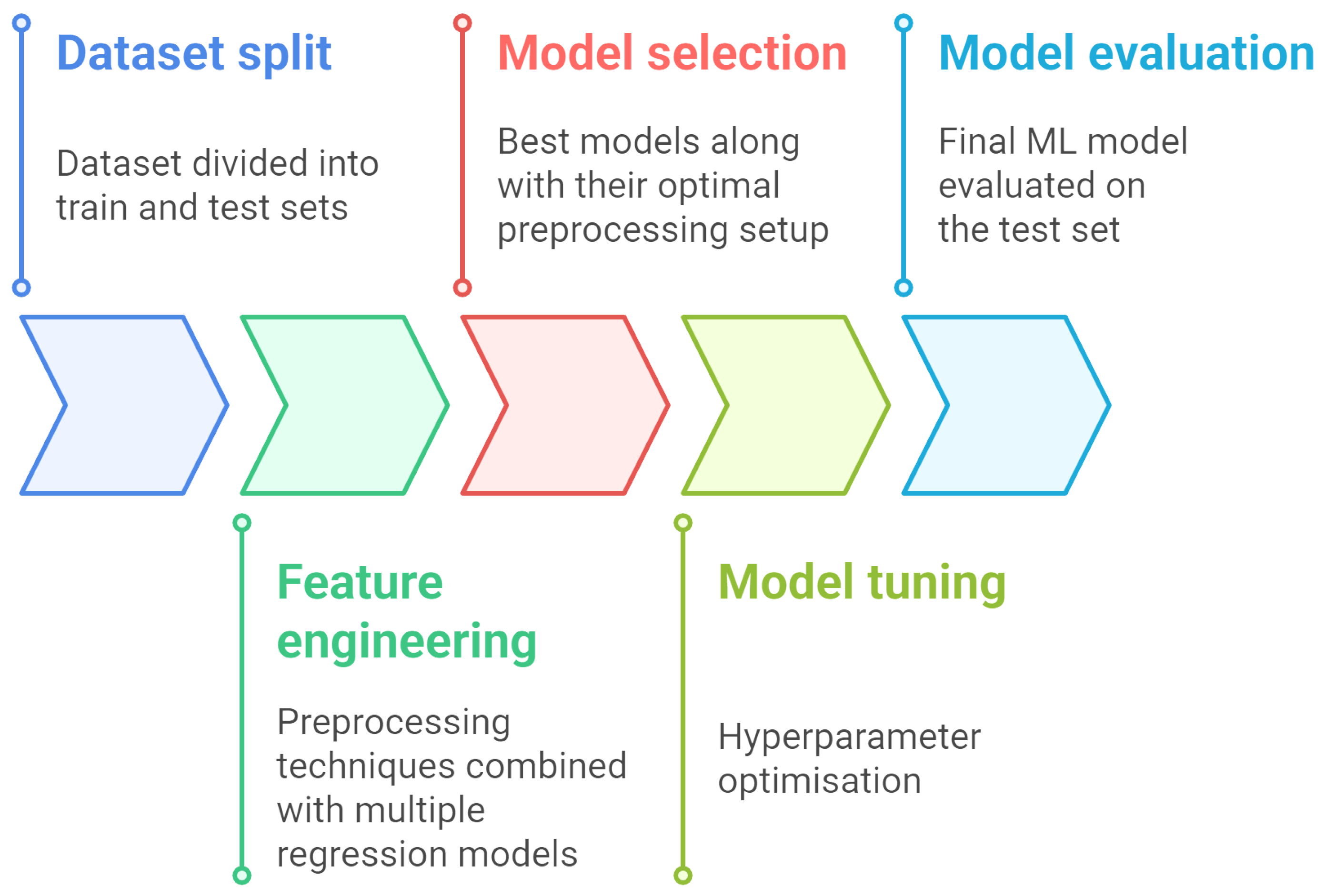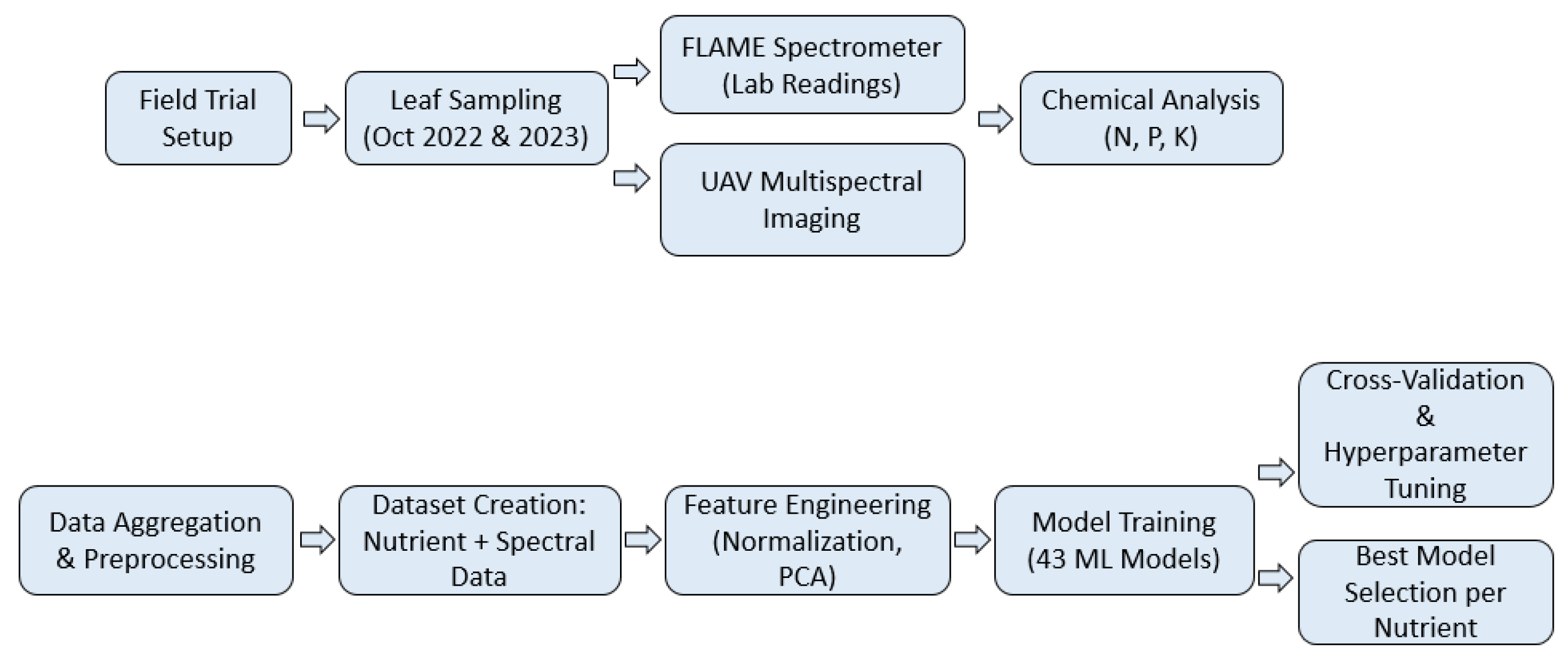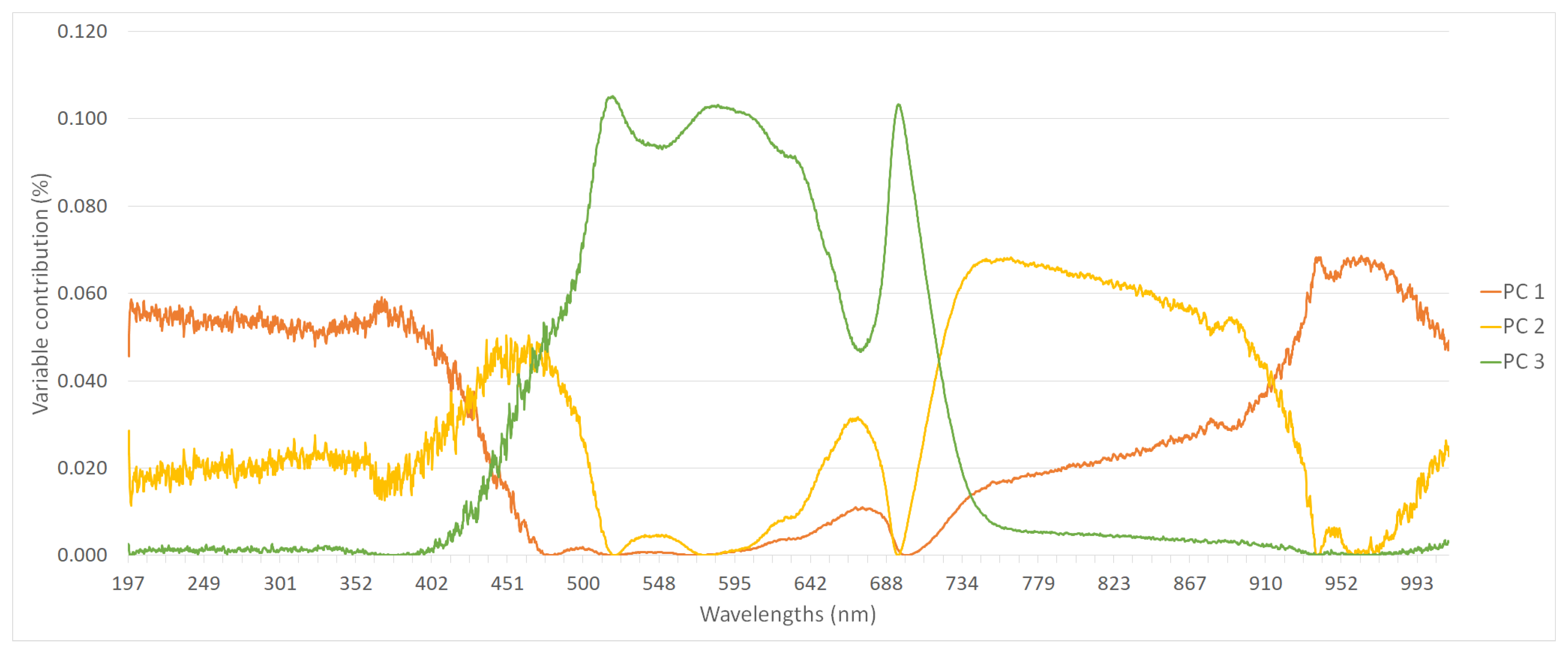1. Introduction
In Europe, olive groves cover approximately six million hectares, with Spain, Italy, Greece, and Portugal being the leading producers [
1]. In Portugal, olive cultivation holds significant agricultural, economic, and cultural importance. It represents a major component of the country’s agricultural production, particularly in the Alentejo region, where modern irrigation systems, such as the Alqueva project, have supported the expansion of intensive and super-intensive olive groves, occupying around 61% of this irrigation perimeter, equivalent to 68 659 ha [
2]. Portugal ranks among the top global producers of olive oil, which is a vital export that supports rural economies and generates employment across the value chain—from cultivation to processing and distribution. Beyond its economic role, olive trees are well suited to the Mediterranean climate and poor soils, thriving in semi-arid regions where other crops may struggle. Culturally, olive production is deeply embedded in Portuguese heritage, with centuries-old traditions and several olive oils that hold a Protected Designation of Origin (PDO) status. Environmentally, olive trees are relatively drought-resistant and contribute to sustainable farming practices through low water demands and potential carbon sequestration, making them valuable in the context of climate change and ecological preservation, with relatively low phytosanitary requirements [
2].
Olive production in Portugal, while economically and culturally vital, faces several key challenges that threaten its sustainability and long-term productivity. The intensification of olive cultivation, particularly through high-density hedge systems, has raised significant environmental concerns. Excessive or inappropriate use of mineral fertilisers contributes to ecosystem pollution and degrades soil and water quality [
3,
4]. Despite being essential for ensuring competitive yields, fertilisation strategies must consider soil and foliar analyses and align with the crop’s phenological stages to ensure nutrient efficiency and reduce environmental risks [
3]. Considering the heterogeneity of olive groves, the adoption of site-specific fertilisation strategies, such as variable rate application (VRT), can improve resource efficiency and promote environmental sustainability [
5], as over-fertilisation compromises soil structure and microbiological function and contributes to nutrient leaching and eutrophication of water bodies [
6]. Soil plays a fundamental role in sustaining life and ecosystem functions, with its health being essential for biodiversity and sustainable agriculture. Although modern agriculture heavily depends on chemical fertilisers (nitrogen [N], phosphorus [P], and potassium [K]) to increase crop productivity and soil fertility, its overuse leads to a decrease in soil organic matter and pollution, degrading soil quality, suppressing microbial activity, and harming overall environmental health. Long-term use of chemical fertilisers alters soil properties, shifts pH, encourages pests, and increases greenhouse gas emissions, ultimately threatening soil biodiversity and ecosystem well-being [
7]. Climatic variability, particularly drought and irregular precipitation, has a direct impact on yields, notably in southern regions, such as Alentejo, where irrigation is indispensable. Additional pressures include soil nutrient depletion, biotic stresses (e.g.,
Bactrocera oleae and fungal pathogens), rising costs of agricultural inputs, and compliance with evolving environmental regulations, such as the EU’s Farm to Fork strategy. These challenges underscore the urgent need for the adoption of more precise, efficient, and sustainable management practices in the sector, hence the importance of promoting Precision Agriculture to address these challenges [
8,
9].
Technological advances are transforming agriculture by providing accurate data for improved management and decision-making. These technologies help to understand soil type, optimise water use, manage nutrients and protect crops from pests and diseases. Remote sensing, artificial intelligence and machine learning (ML) are particularly valuable for early detection and prediction of pest outbreaks, enabling targeted, sustainable pest management that reduces reliance on pesticides and minimises environmental impact. Despite challenges with data quality and access to technology, the integration of these tools has the potential to increase agricultural resilience and sustainability [
10]. In recent years, ML techniques have significantly impacted the development of agricultural decision support systems. These techniques make use of multi-source data to create models that provide valuable agricultural insights, estimate or classify essential plant status indicators, and predict crop outputs. Some examples of applications, as reviewed by Benos et al. [
11], include stress physiology [
12], stress phenotyping [
13], plant identification [
14], plant system biology [
15], plant breeding [
16], plant genetic engineering [
17], pathogen identification [
18] and in vitro culture [
19].
Fertilisation, although being extremely important, represents a high percentage of the crop production costs [
20]. Given this cost constraint, precision fertilisation management for olive growing aims to develop crop monitoring tools that allow immediate diagnosis, shifting from parcel-level analysis to targeted monitoring throughout the crop cycle [
21]. The first studies that evaluated the use of remote sensing in quantifying stress derived from N content were based on empirical relationships with spectral indices sensitive to chlorophyll content [
22]. In 2017, Martínez M [
23]’s analysis of leaf N, P, and K content in various crops showed a strong correlation with spectral indices derived from both the spectrometer and satellite images, especially in indices involving the red band. In contrast to N, research into the development of non-invasive methods for determining the P and K content in leaves is scarce, underscoring the need for additional research. However, studies conducted under controlled laboratory conditions using leaf-scale analysis have shown that non-invasive methods, such as hyperspectral imaging and chemometric modelling, can accurately predict P and K levels in plant tissues. These findings highlight the strong potential of advanced sensing techniques for precise macronutrient monitoring, eliminating the need for destructive sampling [
24,
25].
A wide range of sensors is being used for the sustainable management of fertilisation. Roma et al. [
6] developed a methodology on a GIS platform, using GEOBIA algorithms fed by spectral data collected with a multispectral camera mounted on an unmanned aerial vehicle (UAV), to construct prescription maps for variable rate N fertiliser application in an olive grove, and they managed to reduce the application of N fertiliser by around 31%. Brambilla et al. [
26] applied a low-cost RGB sensor to assess the nutritional status of basil, and the results demonstrated that the sensor effectively tracked plant development in response to varying N application rates (0, 2.5 mM and 10 mM N with different NO
3−/NH
4+ ratios), showing a clear correlation between the sensor readings and the different levels of N applied. Chungcharoen et al. [
27] applied ML to determine the nutritional status in oil palm leaves using proximal multispectral images and provided statistically significant predictions for chlorophyll and macronutrient levels (N and K) in leaves. Using drone images of a wheat field, Lysenko et al. [
28] obtained a strong relationship between the colour intensity of wheat leaves and N content. Also, for the estimation of the N nutritional index in a rice crop, Qiu et al. [
29] achieved a determination coefficient (
) circa 0.9, by combining the random forest regression method with vegetative indices extracted from RGB images from a drone, while Zha et al. [
30] achieved a
value of up to 0.79 using multispectral data. By extending the estimation to more nutrients, Noguera et al. [
5] estimated the quantity of the primary macronutrients using neural networks applied to images of an olive grove, obtained using a multispectral camera attached to a drone, and achieved an
value of 0.63 for N, 0.89 for P, and 0.93 for K.
The aim of this work was (i) to validate the data collected with both a proximal sensor (FLAME spectrometer) and a remote detection sensor (multispectral) assembled to a UAV, using as reference the ground-truth data from foliar chemical analyses of the olive grove, and (ii) to use ML techniques to assess the nutritional status of olive trees, minimising reliance on time-consuming, invasive methods.
4. Discussion
The objectives of this research were as follows: (i) To validate the information collected with two different sensors—a proximal sensor (FLAME spectrometer) and a remote detection sensor (multispectral), coupled to a UAV—using the ground-truth data obtained from foliar chemical analyses as references. (ii) To train predictive models through ML techniques. With these two objectives in mind, we intended to be able to determine the nutritional status of our crop via remote and/or proximal sensing data, specifically regarding its main macronutrients: N, P, and K.
In evaluating the sensors used to assess the nutritional status of olive trees, the FLAME spectrometer demonstrated the highest accuracy for estimating N content (
Table 4). For P and K, both the FLAME and multispectral sensors showed comparable performance (
Table 3 and
Table 4). The difference in data acquisition methods partly explains these results. The multispectral sensor captures imagery from an altitude of 45 m, providing a vertical perspective that primarily samples the upper canopy area, characterised by active vegetative growth. In contrast, the leaves used for the FLAME spectrometer readings were fully developed leaves on the lateral sides of the canopy, where nutrient concentrations of N, P, and K differ from those found in younger top-canopy, as noted by Fernández-Escobar et al. [
52]. Also, the FLAME spectrometer operates in controlled laboratory conditions, where measurements are taken directly from individual leaves. This eliminates noise from external environmental factors, like light variability, dust and canopy shading, leading to more reliable nutrient estimations [
53]. Its superior performance in estimating N may also stem from its broader spectral range (200–1025 nm) compared to the narrower range of the multispectral sensor (475–717 nm). Hyperspectral sensors operating in the short-wave infrared (SWIR) range from 1000 to 2500 nm are known to outperform those in the visible–near-infrared (VNIR) range (400–1000 nm) for N detection [
54]. Because the FLAME spectrometer encompasses a wider range of wavelengths, it captures more detailed spectral information, resulting in enhanced predictive accuracy. As noted by Sandino et al. [
55], higher spectral resolution improves data quality and analytical outcomes. This advantage is further reinforced by the fact that the FLAME measurements were taken from the same leaves analysed for chemical composition, providing direct correspondence between spectral and laboratory data. Additionally,
Table 5 highlights that certain wavelength bands used by the spectrometer, but not available in the multispectral camera, are more sensitive to variations in N levels, further explaining the FLAME sensor’s superior performance.
The application of the PCA to our data, even though it allows the dimensionality to be reduced by around 99.8% while preserving 99% of the explained variance, consists of an unsupervised method, where the selection of axes does not necessarily comprise the weighted sum of the wavelengths with the most significant importance for estimating the leaf nutrient contents. When filtering the data from the FLAME spectrometer to cover only the five bands that make up the multispectral sensor (
Table 5), the results of N and K were slightly lower than those of the multispectral one. This suggests that for the FLAME spectrometer, there are additional critical bands outside the 475–717 nm range that are essential for the estimation of key macronutrients that were hidden in the filtering process.
The improved performance of ensemble learning models, such as Extra Trees and Gradient Boosting, as well as NuSVR, Partial Least Squares (PLS) and K-Neighbors, can be attributed to their respective strengths in handling small datasets with low features, as seen in
Table 3 and
Table 4. Even under such conditions, ensemble learning models are robust when learning complex patterns. Extra Trees reduce variance by averaging predictions from multiple randomised decision trees and are therefore good at preventing overfitting [
56], whereas Gradient Boosting reduces bias by summing up successive improvement in predictions using additive modelling [
57,
58]. Likewise, NuSVR, a
-parametrised support vector regression (SVR) model, is famous for its robustness in high-bias, low-variance conditions [
59]. PLS regression, which projects predictors into a lower-dimensional space before modelling, is also suitable for small, collinear datasets [
60]. Lastly, the K-Neighbors model, while simple, can be highly effective when the local data structure is informative [
61]. Overall, the success of these models underscores the merit of model selection based on dataset properties, especially when working with limited data.
The models used had the highest correlation when estimating the leaf concentration of the main macronutrients, P and K, and were slightly less accurate for N, in line with the results obtained by Noguera et al. [
5]. The lower precision (
) in estimating N can be explained by several factors that affect the spectral reflectance of leaves, particularly under field conditions. One possible explanation could be related to the leaf morphological structure, and the fact that deficit irrigation is practised in the olive grove where the study was carried out (1000 m
3 ha
−1 per year). In
Eucalyptus grandis, the spectral reflectance of fresh leaves is strongly influenced by the water content and the internal structure of the leaves [
62]. This interference may be even more pronounced due to the unique leaf characteristics of each plant species, such as a thick cuticle and high drought tolerance, which affect the reflectance and make it difficult to accurately estimate N. Regarding green leaves, the layer that corresponds to the spongy mesophyll controls the amount of near-infrared energy that is reflected [
63]. Rico et al. [
64] intended to estimate the main macronutrients in olive cultivation by using multispectral data obtained by a UAV and creating models to predict leaf nutrient content in olive trees, applying SVR. Their results showed good precision for estimating N, P, and K, with
varying from 0.76 to 0.91 for the ‘Hojiblanca’ cultivar, and from 0.79 to 0.80 for ‘Picual’. In a vineyard, Peng et al. [
65] reported
values of 0.81 for N, 0.77 for P and 0.80 for K, and in ’Valencia’, they reported orange values of 0.91 for N, 0.77 for P and 0.76 for K [
66].
Regarding
Table 6 and
Table 7, we observed that the
values in both cases indicate that, overall, the models do not establish a stronger relationship between vegetative indices and nutrient quantity than when the bands of the spectrum alone are considered alternatively.
5. Conclusions
Good plant nutrition is essential to achieve high yields, in both quantitative and qualitative ways. As such, plant and/or soil fertilisation procedures are the main cultural practices being used to regulate the quantity of nutrients available to plants. To optimise the use of fertilisers, it is essential to measure the plant nutritional status. However, the classic destructive methods are highly time-consuming and require a lot of physical labour in order to have a precise and high representative sample of a field. Therefore, the methods presented in this paper, based on non-destructive, remote or proximal analyses, are a valuable tool for olive growers for evaluating the nutritional status of plants. This study demonstrates the potential of non-destructive sensing technologies—namely the FLAME spectrometer (proximal) and multispectral UAV imagery (remote)—as powerful alternatives for evaluating N, P, and K levels in olive trees. The FLAME spectrometer showed superior accuracy in estimating N content due to its broader spectral range and controlled data acquisition, while both sensors performed comparably in estimating P and K. These methods also enable spatially precise nutrient mapping, which supports variable-rate fertilisation, ensuring that nutrients are applied where and when they are needed most. The methods presented also have the advantage of making it easy to evaluate the spatial variability of fields, enabling the application of a fertiliser at variable rates, enabling the plants to receive sufficient and optimal amounts of fertiliser where they need it. Through VRT, it is possible to optimise resource usage in order to mitigate environmental issues such as nutrient runoff and soil degradation. Both methods provided results with great potential for the farmers, and each one could be more targeted to the farmer’s economic dimension, their willingness to invest in technology, and the level of training. Although these results are promising, more research is needed to explore various environmental conditions, olive varieties and growth stages. Compared to the current methods, this technique is a step forward towards a system for the continuous monitoring of nutrient levels in olive orchards, ultimately leading to smarter and more efficient fertilisation practices, increasing the productivity and profitability of olive orchards, contributing to more sustainable agriculture, and promoting environmentally conscious practices. In the context of modern olive production, which faces pressures such as resource limitations, soil degradation, and the need to reduce fertiliser overuse, these sensor-based approaches offer a timely solution by not only improving the efficiency and sustainability of fertilisation practices but also by reducing our environmental impact. Ultimately, integrating these technologies into routine orchard management can enhance productivity, reduce costs, and contribute to more sustainable and environmentally responsible agriculture. Future research should focus on validating these methods across diverse environmental conditions, olive varieties, and growth stages to further improve their robustness and applicability.










